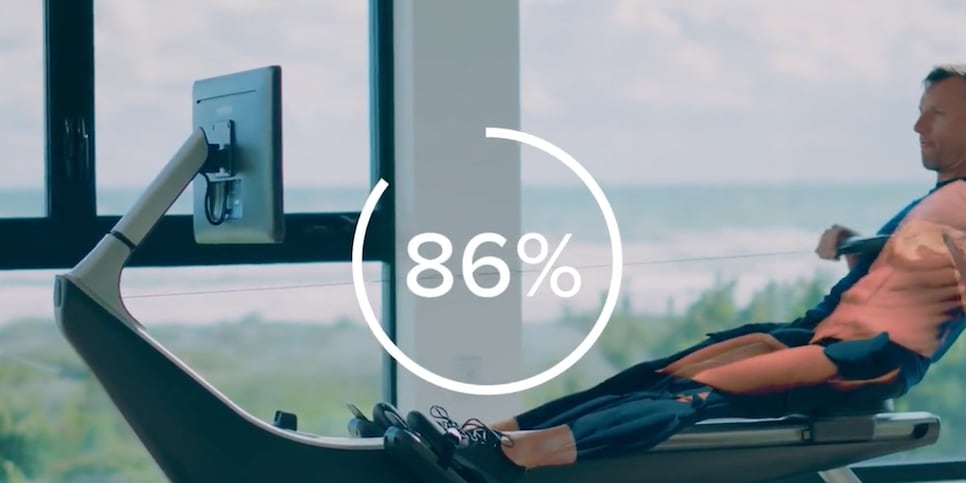[PHOTO: Felix Cesare]
I really love golf, and I really hate working out. Which is unfortunate, because working out is really good for your golf game. Getting stronger and more flexible can make your golf swing better, and of course, improve your health off the golf course, too.
It’s been hard for me to square these two things—my desires to be a better golfer and a healthier person without working out. But recently, I’ve stumbled upon one thing that has really helped.
Rowing.
I’m not rowing on water (at least not yet). But rather, I’ve committed to doing near-daily workouts on a Hydrow rowing machine I recently set up in my garage. I’ve found them strangely enjoyable, for a few reasons: I like that I don’t have to row for ages in order to get a heart-racing workout in. I can go faster or slower, and after each workout I feel it in some pretty crucial golf muscles, from my legs to my shoulders.
And all of that aside, there’s just something about the act of rowing that feels, for lack of a better word, golf-y.
Curious about all this, I decided to give a couple of Hydrow’s rowing coaches, Nick Karwoski and Laine Maher, a call. The pair are expert rowing coaches and avid recreational golfers. The perfect people to help me unpack all this.
Could it be that rowing is a top-tier exercise for golfers? One you should consider trying, too? They certainly think so. Here’s why…
1. It hits some key golf muscles
Golf swings are difficult to do well because they require lots of different muscles. If there’s a weakness or inflexibility in one area of your body, it can disrupt the entire chain of your golf swing.
The same is true with rowing, a motion which, by most estimates, hits up to 86 percent of your muscles—including some important ones for golfers.

“The biggest areas [in rowing] are your glutes in your legs, because essentially you’re doing a horizontal squat with every rowing stroke, loosens your hip flexors,” Karwoski says. “The rowing motion starts using the significantly bigger, stronger muscles in your legs, then you transfer through your core and finish with those biceps, triceps, shoulders, and lats.”
All those muscles play an equally active role in swinging the golf club. Turns out rowing can help strengthen, loosen, and activate all those areas. But that’s not where the similarities end.
2. There’s a sequence, just like in golf
No two golf swings look identical—even at the highest level of the sport. But the best ones all work because they have the same general sequence of events. They start their downswing with a later shift of their lower body, then begin rotating before finally pushing off the ground and rising to the finish.
This sequence is the most important move in the golf swing, and organises your muscles for maximum power. When your sequence gets off, golfers start losing power and consistency. The same is true in rowing, where the sequence involves a push from the legs, followed by a lean away with your upper body, then a final pull with your arms.
“In the rowing sequence, there are two really big mistakes. The first is just pulling too soon. The second is bending their knees too early, trying to start their next stroke as fast as they can,” Maher says. “Like golf, rowing is a sport of leverage. If you pull first and break your knees, you’re immediately breaking that chain of power.”
3. Tempo plays a huge role
Rushing, in both golf and rowing, is a sequence killer. In both sports, the rushing most often occurs in the reversing of direction—from backswing to downswing in golf, and from catch to release in rowing. Rowing is a little like hitting balls on the driving range, in that regard. You can quickly go from one stroke to the other, using steady repetition to engrain the feel of blending both rhythm and technique.
“The two words I would think of in both golf and rowing are rhythm and fluidity,” Maher says. “There’s a tempo to it. Learning how to go faster or slower. The more that you can be technical in your movements, but make it seamless as you move from one move to the other, the better off you’ll be.”
4. It’s an explosive movement
One of the many challenges in golf is learning to generate power from, effectively, a standing still position. Like throwing a ball really hard, or jumping really high, or picking up something really heavy; it requires an explosive quality. That can be hard for golfers—especially older golfers—to train. But rowing, because of how the motion relies on a big push from the legs for power, can help.
“Rowing is about exploding, then recovering, then pressing and exploding again,” he says. “It’s very similar in golf. When I’m about to hit my shot, I focus on my posture and setup first, then once I’ve completed my backswing, that’s when I’m in a position for an explosive movement.”
This article was originally published on golfdigest.com



